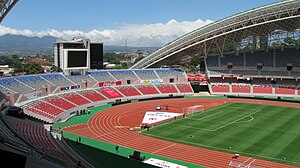Estadio Nacional de Costa Rica (2011)
| La Joya de La Sabana | |
 |
|
 |
|
| Location | San José |
|---|---|
| Coordinates | 9°56′11″N 84°6′28″W / 9.93639°N 84.10778°WCoordinates: 9°56′11″N 84°6′28″W / 9.93639°N 84.10778°W |
| Capacity | 35,175 |
| Surface | Grass |
| Scoreboard | Yes |
| Construction | |
| Broke ground | 2008 |
| Built | 2009–2011 |
| Opened | March 26, 2011 |
| Construction cost | US$110 million |
| General contractor | Anhui Foreign Economic Construction |
| Tenants | |
|
Costa Rica national football team 2013 Copa Centroamericana 2013 Central American Games 2014 FIFA U-17 Women's World Cup |
|
The National Stadium of Costa Rica (Spanish: Estadio Nacional de Costa Rica) is a multi-purpose stadium in La Sabana Metropolitan Park, San José, Costa Rica. It is the first modern sport and event arena to be built in Central America. The stadium was completed in 2011 and officially opened its doors to the public on Saturday, March 26 of that same year, with a capacity of 35,175 seats. The stadium replaces the original National Stadium. It also serves as the home stadium of the Costa Rica national football team.
It has one high-definition 160-square-metre (1,700 sq ft) screen, located in the southern section of the stadium, along with a smaller monochromatic screen, and another monochromatic screen of the same dimensions in the northern section.
It was used to host matches during the 2014 FIFA U-17 Women's World Cup, including the opening game, the third place match and the Final.
Although the cost was programmed at the beginning to around $88 million, this was later adjusted to $100 million.
The Chinese government financed the construction of the stadium in its totality, along with its furnishing, and assumed all other costs. Demolition of the old National Stadium began May 12 of 2008, after the match between UCR (Universidad de Costa Rica) and Brujas FC and the 200M event where Nery Brenes set a new national record (20:28 seconds).
The construction of the stadium formed part of the agreements signed between the presidents of Costa Rica and China, Óscar Arias and Hu Jintao, respectively, during Arias' first visit to the Asian country in October 2007. The construction began on March 12, 2009 and finished in 2011.
...
Wikipedia
